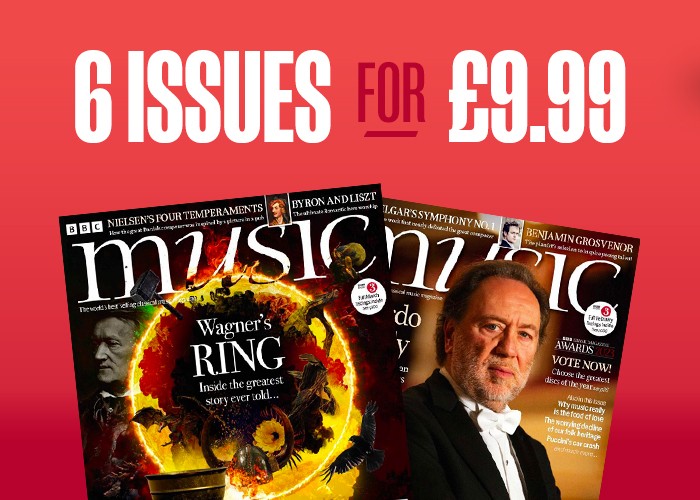Which is the best Mahler symphony?
All nine Mahler masterpieces ranked worst to best

There’s no doubt that Mahler’s symphonies are among music’s greatest creations, each extraordinarily rich, both orchestrally and thematically. But while none of them are any less than fine, some are undoubtedly better than others. Here’s our ranking of all nine, bottom to top
- The 20 Greatest Symphonies of all time
- The 50 Greatest Composers of All Time
- The world’s top ten orchestras
The best Mahler symphonies
9. Mahler Symphony No. 8
In ninth position is Symphony No. 8. From whatever direction you choose to view it, Mahler’s Eighth is his most outrageously ambitious symphony and, we’d argue, the most self-indulgent of them all. With a vast, colour-enhanced orchestra, forests of choral voices and enough soloists to fill a lavish grand opera stage, Mahler starts with a medieval invocation to the Holy Spirit, then proceeds to the final scene of Part Two of Goethe’s Faust – not just one of the sacred high points of German literature, but set entirely in Heaven, and featuring a special guest appearance by the Virgin Mother of God.
Unsurprisingly some critics have called it pretentious, dismissed Part Two as a paradise of kitsch, or – wielding a subtler knife – argued that Mahler simply didn’t do up-beat very well: that he was more truly himself when evoking doubt or despair. Others have found it possible to approach this so-called ‘Symphony of a Thousand’ with all kinds of mental reservations and still be blown away by the emotion – ecstatic, sensuous and just a bit unnerving. Is it this that prompts some listeners to raise their critical hackles?
Art is much easier to deal with when we can consider it at a distance, ‘objectively’. Mahler has a way of digging under defences and shaking us into feeling along with him. ‘Only when I experience intensely do I compose, and only when I compose do I experience intensely,’ he wrote. You decide…
Best recording: Chicago Symphony Orchestra/Georg Solti Decca 475 7521
8. Mahler Symphony No. 6
The young Alban Berg attended the premiere of Mahler’s so-called ‘Tragic’ Sixth Symphony in Essen on 27 May 1906 and immediately recognised its ground-breaking significance. He even made favourable comparison to Beethoven, describing Mahler’s vast work as ‘The only Sixth – despite the Pastoral’.
Scored for a huge orchestra, it includes many novel effects, notably the distant cowbells that evoke the rarefied air of alpine pastures – Mahler was much lampooned for this and other alleged excesses. But it is also unmistakably bleak in its outlook, and it remains something of a mystery why Mahler should choose to compose his most doom-laden work during what seemed to be the rosiest period of his life. Were the infamous hammer blows that we hear in the final movement a portent of his own death?
On the other hand, the string melody of the ‘Alma theme’ which interrupts the opening Allegro’s march is paradoxically optimistic. It is, though, a symphony that begins in A minor and ends in A minor... and ultimate destruction.
Best recording: Bamberg Symphony Orchestra/Jonathan Nott Tudor TUDOR7191
7. Mahler Symphony No. 5
Ask anyone which Mahler symphony they should head for first, and many with say the Fifth, without hesitation. Yes, it has instant appeal, and the Adagietto is admittedly one of the most sublime moments in all music. But is it all just a little bit overblown?
More like this
Behind its genesis is Mahler’s brush with death caused by a violent intestinal haemorrhage, and his marriage to Alma Schindler (‘superhuman love’) a year later – both are often cited as major biographical stimuli for Mahler’s Symphony No. 5 (1901-02), inspiring both the death-haunted turbulence of Part One, that tender, impassioned Adagietto mentioned above – strikingly used in Visconti’s 1971 film Death in Venice - and the exuberant Finale.
But it’s important to note that the Fifth is the first symphony for which Mahler himself provided no detailed programme notes, no extra-musical aids to interpretation. The human voice, so prominent in Symphonies Nos 2-4, is also abandoned (‘There is no need for words – everything is purely musically expressed’). It’s clear Mahler was aiming in the Fifth at a new beginning.
Best recording: Southwest German Radio Symphony Orchestra/Michael Gielen Hänssler CD 93.101
6. Mahler Symphony No. 7
Following close behind No. 1 is the Seventh, perhaps the most controversial of Mahler’s nine completed symphonies. Beloved of the Second Viennese School of Schoenberg, Berg and Webern, its psychedelic mix of the sublime and the banal still polarises opinion more than a century on.
In part a Nature symphony, and sometimes referred to as ‘Song of the Night’ (though not by Mahler himself), it takes the listener on a paranormal voyage from darkness to light. The first movement is essentially a succession of marches. Then follows the nocturnal soundscapes of the two Nachtmusiken (‘Night music’) movements, the second of which features Mahler’s only symphonic use of the mandolin. In between the two lurks a shadowy Scherzo – a kind of distorted Viennese waltz, with pre-echoes of Ravel’s La Valse. The Rondo Finale is all fanfares, jangling bells and cymbal smashes.
Once upon a time the Cinderella of Mahler’s symphonies, the Seventh, which in the 1980s was famously used for a motor oil TV commercial, is today no stranger at the ball.
Best recording: New York Philharmonic/Leonard Bernstein Sony Classical SMK60564
The top five Mahler symphonies
5. Mahler Symphony No. 4
As we’ve mentioned above, Mahler insisted his symphonies were ‘whole worlds’, embracing his literary tastes, his neuroses, responses to ‘nature’ and, most especially, the inexorable cycle of life and death. As if to emphasise the point and make the meaning of his music even clearer, Mahler cross-fertilised his vocal settings and symphonic masterpieces to the point that the two became virtually inseparable.
Nowhere is the intimate connection between Mahler’s creative progeny made more explicit than in the case of the Fourth Symphony’s finale, a radiant setting of the song ‘Das himmlische Leben’ (‘Heavenly Life’). At first, Mahler struggled to find a stylistic solution that would complement the mood of ‘Das himmlische Leben’, but he made the breakthrough with an opening movement that anticipates the song’s glowing simplicity, but with almost neo-classical concision.
The scherzo bristles with energy and stinging irony, yet in the second movement of the Fourth, as befits a child’s view of the world, the mood is more relaxed, with only the sound of a scordatura violin (tuned up a whole tone) providing fleeting moments of shadowy discomfort.
Mahler subtly anticipates the mood of the finale in two contrasting trio sections, yet it is the awesome serenity of the third movement’s variations that points the way forward, setting up the key of the finale with a cathartic explosion of sound in E major towards the end, symbolising the gates of Heaven opening up.
Best recording: Budapest Festival Orchestra/Iván Fischer Channel Classics CCSSA26109
4. Mahler Symphony No. 1
This may have been Mahler’s first symphonic statement, but it’s still one of his best. Mahler began his Symphony No. 1 in 1884, completing it four years later. Initially, the work had five movements, but in 1896, Mahler took out the second of them – an Andante called ‘Blumine’ – leaving the four-movement version familiar today. In the first movement, Mahler depicts the awakening of nature in spring, complete with cuckoo calls and other bird song.
The second movement presents a slightly distorted version of an Austrian Ländler dance, while the famous third movement depicts a funeral march through a forest, its tune based on ‘Bruder Martin’ (a German version of Frère Jacques), interspersed with Klezmer tunes. The finale, meanwhile, sees themes from earlier make a reappearance, before all is rounded off in a typically Mahlerian blaze of glory.
Best recording: Bavarian Radio Symphony Orchestra/Rafael Kubelik DG 4497352
3. Mahler Symphony No. 2
Mahler Symphony No. 2 was the first of the nine to use vocal soloists and a choir – a habit Mahler got rather used to in future symphonies. Lasting in the 90-minute region, ‘The Resurrection’ Symphony Symphony however, starts as a purely instrumental work, its first three movements kicking off with a menacing funeral march, depicting the ‘hero’ of the First Symphony being carried to his grave.
The following movements take us back to both happier and more conflicted times before the fourth and fifth movements sees the hero responding to a call from God and, in the finale, facing the Day of Judgement. It’s a glorious work, full of some of Mahler’s most imaginative and awe-inspiring moments, and its closing moments, with full orchestra, organ, bells and huge chorus, are enough to guarantee this work a place in the upper echelons of Romantic symphonies. A truly spiritual experience.
Best recording: Berlin Philharmonic/Simon Rattle Warner Classics 6473632
2. Mahler Symphony No. 3
When Mahler met Sibelius in 1907, he told him that ‘a symphony must be like the world, it must embrace everything’. In none of his nine completed symphonies did Mahler come closer to filling that prescription than in the Third, premiered five years previously.
Nowadays we’d say the Third has an ecological agenda. The opening movement – all 35 minutes of it – depicts the natural world awakening, its primeval heavings eventually engendering life from ‘soulless, rigid matter’. Primary sensual phenomena infuse the music, with its ‘atmosphere of brooding summer midday heat’ where ‘all life is suspended, and the sun-drenched air trembles and vibrates’.
In movements two and three flowers sway elegantly in the meadows, and birds and beasts disport themselves in the forest. The arrival of humankind in the ‘very slow, mysterious’ fourth movement brings introspection, resolved in the pantheistic love song to all creation in the sublime, lingering finale. It’s long, but it’s an aural adventure, to be sure.
Best recording: Bavarian Radio Symphony Orchestra et al/Bernard Haitink BR Klassik 900149
1. Mahler Symphony No. 9
In first place is Mahler Symphony No. 9. This is a glorious apotheosis and a brave new dawn. Scored for vast orchestral forces – huge woodwind and brass, with a percussion section that includes timpani, bass drum, side drum, triangle, cymbals, tam-tam, glockenspiel and three deep bells – the most striking thing about its soundworld is Mahler’s exquisite handling of sonorities.
Despite its expansive timescale of around 85 minutes, much of this music feels as though it is sustained under superheated compression. There are times when Mahler takes us to the brink of atonality as the four movements progress unconventionally from D major to C major to A minor to D flat major for the Adagio finale.
Yet it all feels intuitive, natural and logical. Saving his best till last, the finale hovers on an emotional knife-edge between a serene acceptance and the bitter resignation of a man, still only 50, suffering from a congenital heart condition, and destined to bow out after a completed Ninth. This is Mahler at his very best.
Best recording: Lucerne Festival Orchestra/Claudio Abbado Accentus Music ACC20214
Read our reviews of the latest Mahler recordings here
Read more about Mahler and his works here
Five essential works by Mahler
Authors

Oliver Condy is the former Editor of BBC Music Magazine, a post he held for 17 years. His debut book, Symphonies of the Soul: Classical Music to Cure Any Ailment, will be released in November 2021 with Octopus Books. He is also a semi-professional organist, having previously given recitals in Bach’s churches across Germany.




